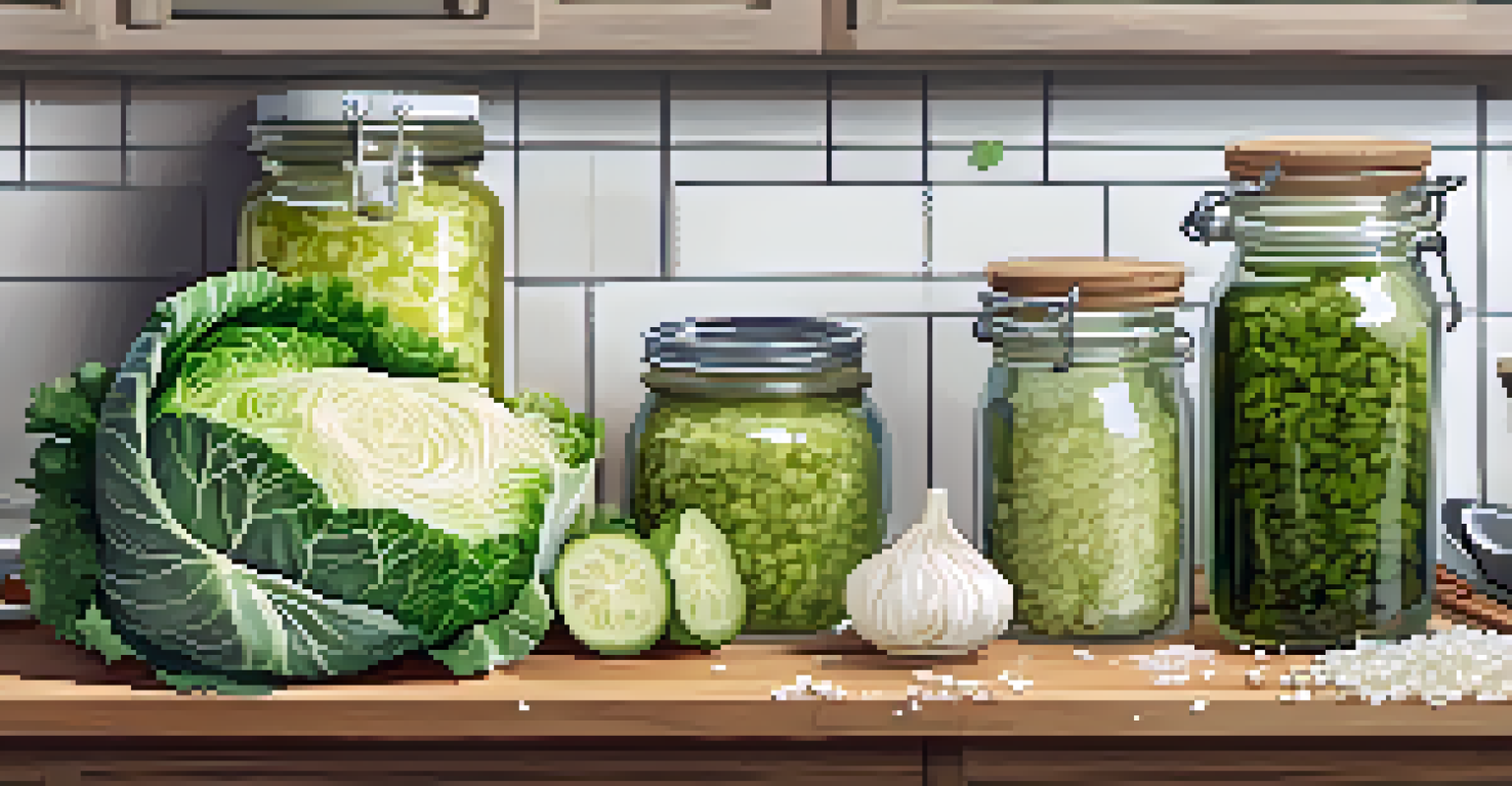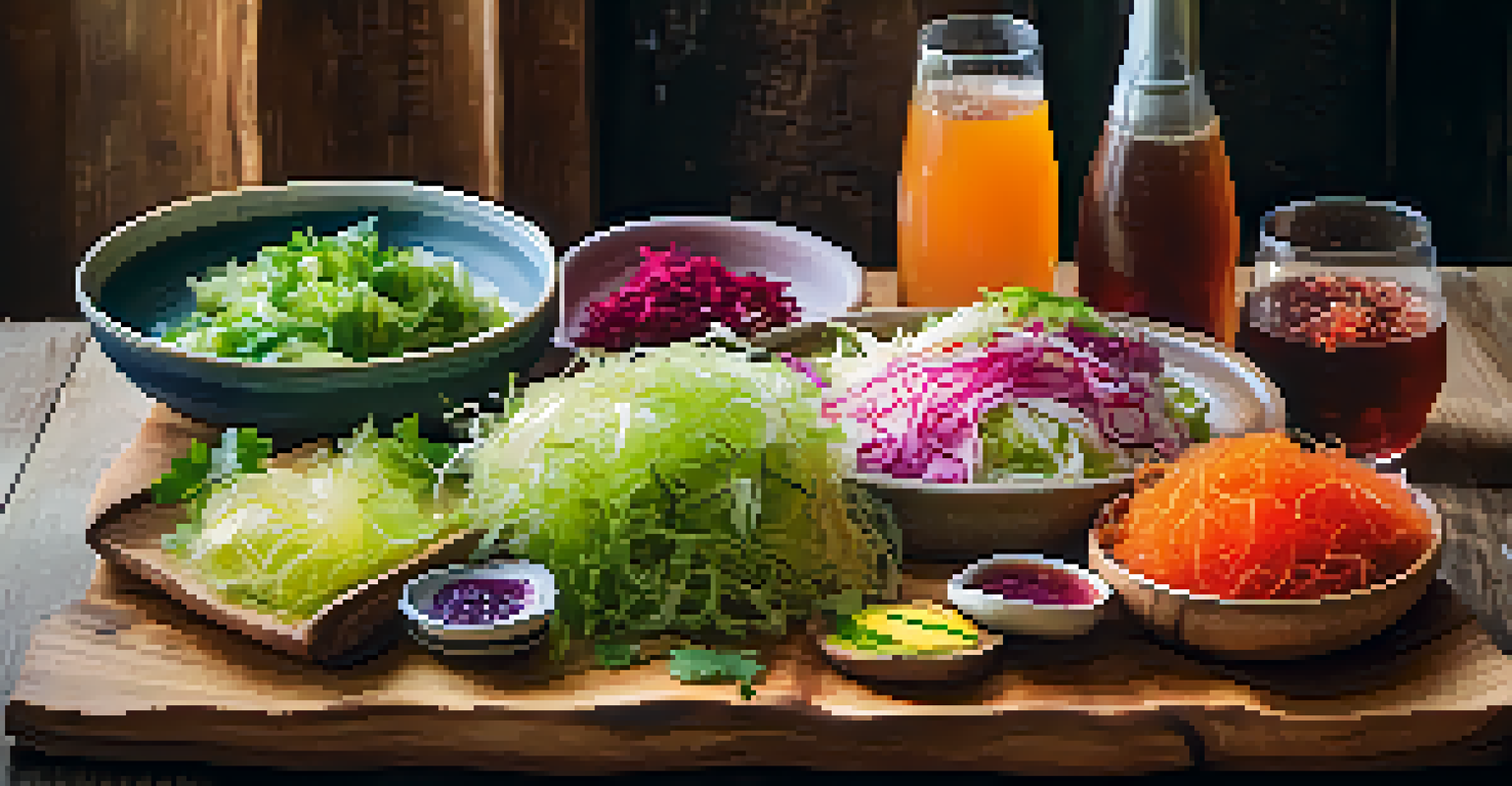Fermented Raw Foods: A Complete Beginner's Guide

Understanding Fermented Raw Foods and Their Benefits
Fermented raw foods are essentially foods that have been transformed through the action of beneficial bacteria and yeasts. This process not only preserves the food but also enhances its nutritional value, making it easier for our bodies to absorb nutrients. Think of fermentation like nature’s way of supercharging our food, creating delicious flavors and textures.
Food is our common ground, a universal experience.
One of the most appealing aspects of fermented raw foods is their health benefits. They are rich in probiotics, which support gut health and boost the immune system. Just imagine your gut as a bustling city; probiotics help keep the traffic flowing smoothly, preventing the buildup of harmful bacteria.
Moreover, incorporating these foods into your diet can lead to improved digestion and greater overall well-being. With options ranging from sauerkraut to kombucha, there's a world of flavor waiting to be explored, turning your meals into a tasty adventure.
The Science Behind Fermentation: How It Works
Fermentation is a natural process that breaks down sugars and carbohydrates in food, turning them into acids or alcohol. This occurs thanks to microorganisms like bacteria and yeast that thrive in anaerobic (oxygen-free) environments. Imagine these tiny workers as nature’s chefs, creating unique flavors and preserving our food.

During fermentation, beneficial bacteria multiply while harmful ones are kept at bay, creating a safe and enjoyable product. This transformation can be visualized as a protective barrier, ensuring that only the good stuff survives while the bad stuff is kept out. It's this balance that makes fermented foods not only safe but also incredibly nutritious.
Health Benefits of Fermented Foods
Fermented raw foods are rich in probiotics, which support gut health and enhance nutrient absorption.
Additionally, fermentation can enhance the bioavailability of nutrients, meaning your body can absorb them more effectively. For instance, the fermentation of grains breaks down anti-nutrients, making vitamins and minerals more accessible, much like clearing a path in a dense forest.
Popular Types of Fermented Raw Foods to Try
When diving into the world of fermented raw foods, there are a few popular options that are perfect for beginners. Sauerkraut, made from fermented cabbage, is a classic staple that packs a tangy punch. On the other hand, kimchi, a spicy Korean favorite, offers a delightful twist with its unique blend of flavors.
The food you eat can either be the safest and most powerful form of medicine or the slowest form of poison.
Kefir is another accessible choice; this yogurt-like drink is filled with probiotics and can be enjoyed on its own or added to smoothies. If you’re in the mood for something refreshing, consider trying kombucha, a fizzy tea that can be flavored with fruits and herbs for a personalized touch.
Each of these foods not only offers distinct flavors but also a variety of health benefits, making it easy to incorporate them into your daily meals. By experimenting with different types, you’ll discover which ones resonate with your palate and lifestyle.
How to Make Your Own Fermented Raw Foods at Home
Making your own fermented raw foods at home is easier than you might think! All you need is a few simple ingredients, some jars, and a little patience. Start with a basic recipe, like homemade sauerkraut, which requires just cabbage and salt to kick off the fermentation process.
Begin by shredding the cabbage and mixing it with salt, allowing the salt to draw out moisture and create a brine. Then, pack the mixture tightly into a jar, leaving some space at the top for fermentation gases to escape. Cover the jar with a cloth or lid and let it sit at room temperature for a week or two, checking on it regularly.
Simple Home Fermentation Tips
Making fermented foods at home is easy with just a few ingredients and proper sanitation practices.
The key to successful fermentation is maintaining the right environment; a cool, dark place helps the beneficial bacteria thrive. Once it reaches your desired tanginess, simply transfer the jar to the fridge to slow down the fermentation process. Voilà! You’ve just created your very own fermented delicacy.
Tips for Successful Fermentation: What to Keep in Mind
When embarking on your fermentation journey, there are a few tips that can help ensure success. First, cleanliness is crucial; make sure all utensils and jars are sanitized to prevent unwanted bacteria from spoiling your efforts. Think of it as setting the stage for a performance; the right conditions will help your microbial actors shine.
Next, don’t be afraid to experiment with flavors and ingredients! While traditional recipes are a great starting point, adding spices, herbs, or different vegetables can create a unique twist. Just like cooking, fermentation is an art, and your personal touch can make all the difference.
Lastly, be patient. Fermentation is a process that takes time, and the results may vary depending on temperature and ingredients. Trust the process and enjoy the excitement of discovering how your efforts transform over days into delicious, nutritious food.
Common Mistakes to Avoid in Fermentation
While fermentation can be straightforward, there are common mistakes that can derail your efforts. One of the most frequent errors is not using enough salt, which is crucial for creating the right environment for beneficial bacteria. Insufficient salt can lead to spoilage, much like forgetting to add crucial ingredients when baking a cake.
Another mistake is neglecting to keep your ferment submerged in its brine. If food floats above the liquid, it can become exposed to air, leading to unwanted mold. To avoid this, use weights or ensure that your jar is tightly packed to keep everything submerged.
Avoid Common Fermentation Mistakes
To ensure successful fermentation, avoid using insufficient salt and ensure food remains submerged in brine.
Lastly, don’t be discouraged by minor mishaps. Fermentation is a learning experience, and even seasoned fermenters encounter issues. Embrace the journey, and remember that each batch offers valuable lessons for your next creation.
The Role of Fermented Raw Foods in a Balanced Diet
Incorporating fermented raw foods into your diet can contribute to a balanced and health-conscious lifestyle. These foods not only add variety and flavor to your meals but also provide essential nutrients and probiotics, supporting gut health. Think of them as a delightful sidekick to your main dishes, enhancing both taste and nutrition.
Moreover, fermented foods can help diversify your microbiome, which plays a crucial role in overall health. A well-balanced microbiome can influence everything from digestion to mood, making fermented foods an important addition to your daily routine. Just like a colorful garden, a diverse microbiome thrives when nourished with a variety of foods.

Ultimately, the key is moderation and variety. Enjoying a mix of fermented raw foods alongside other whole foods can help you reap the full spectrum of their benefits. So, whether it’s a scoop of kimchi with dinner or a refreshing glass of kombucha, you’re taking delightful steps toward a healthier you.